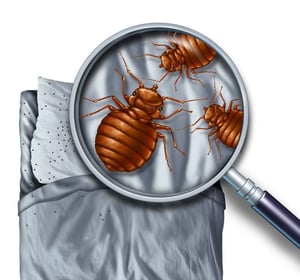If you believe you may have a bed bug infestation, it's very advantageous to act as early as possible. While treatment methods may be inconvenient and moderately costly, the process is far less invasive and expensive, compared to a curative solution for an extensive outbreak. Learning how to properly inspect for bed bugs is an important first step. 
Misidentifying bed bugs is extremely common. Adept hiders, bed bugs can be challenging to find, especially in early-stage, low-level infestations. It is highly recommended to rely on a licensed and experienced Pest Management Professional to perform a thorough bed bug inspection.
Where bed bugs hide
Bed bugs hide in tight spaces, which may make identifying them a challenge, even for trained professionals. Some of the common areas where bed bugs are found include: 
- Mattress and box spring seams
- Bed frames
- Electrical outlets
- Seams of chairs, cushions, pillows, and couches
- Under loose wallpaper
- Within picture frames
- Behind baseboards
- Inside dresser and bureau joints and screws
Treatment methods
There are two primary options for treatment methods to eliminate bed bugs after a positive identification. While both options have pros and cons, it is important to note that eliminating all stages of the bed bug life cycle is critically important. The possibility of reintroduction is moderate to high, and all appropriate corrective action must be taken to increase probability of total elimination.
- Thermal remediation or heat treatments. Bed bugs will die when their body temperature reaches 113 degrees Fahrenheit. Thermal remediation is a highly effective method of control, which provides a high probability of killing all stages of the life cycle. By raising and holding the temperature in a given area to approximately 120 degrees Fahrenheit and holding it at that level for as long as six hours, bed bugs are eliminated, even in the places they're hiding. Companies like Burgess Pest Management go to great lengths to train and invest in the latest technology and remediation methods. With respect to thermal control, the Burgess bed bug team is sought out by housing authorities, hospitals, residential housing complexes, and many other facilities to implement this type of control.
- Conventional applications. The use of residual and no-residual pesticides are another common method of bed bug control. Given the complex nature of bed bug biology and behavior, conventional applications generally require several treatments over a period of time in order to achieve effective control. It is possible, in some circumstances, that a combination treatment approach of thermal remediation plus a conventional application may be implemented in order to achieve control.
Learning how to properly inspect for bed bugs may be helpful in promptly initiating further action, but it is not the professional recommendation of Burgess Pest Management's Pest Management Professionals (PMP's) to rely on untrained expertise and self-treating methods. To find out more about how to properly inspect for bed bugs or achieve bed bug control, click on the tab below.

